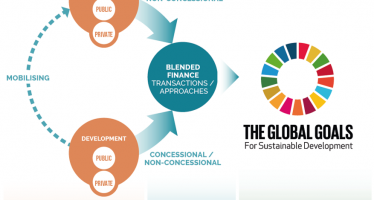Why Even the Most Profit Centered Businesses Should Care About ESG Issues
- Investors and corporations that do not have an explicit mandate to manage social or environmental issues still have an implicit interest in such issues
- The strongest way to manage risk is to consider the broadest number of issues material to all stakeholders
- Financial performance and expected regulatory changes
By T. Robert Zochowski, Program Director Multi-Faculty Impact Investing and Sustainability Special Projects at Harvard Business School

Author: Robert Zochowski
Over the past decade, the proliferation of companies providing ESG metrics has increased substantially by a number of measures. In its 2020 Survey of Sustainability Reporting, KPMG noted that 96% of the G250 companies and 80% of the N100 provided sustainability reports, up from 35% and 24% in 1999 respectively.[1] However, reporting, often provided by a reporting, investor relations, or CSR team does not always equate to action for majority of the organisations. However, I would argue that both corporate executives and investors that do not have an explicit interest in social or environmental issues have a substantial implicit interest in understanding potential impacts and in managing risks related to catalyst events.
Materiality is a concept that is well rooted in financial reporting. In that context, it requires disclosure of all information that is could be reasonably expected to influence the decisions made by the primary users of financial statements on the basis of those statements. The Sustainability Accounting Standards Board, now named the Value Reporting Foundation, has advanced the idea that sustainability information can be material to investors if it is likely to pose a financial risk, and they have provided a number of tools to companies and investors in identifying likely material issues for a given industry. This view of materiality aligns closely with the traditional definition in that the primary stakeholder perspective considered is that of the equity or debt investors. A number of other organisations have advanced the idea of ‘double materiality,’ which is the idea that issues that are material to the aforementioned group as well as issues which are material to other stakeholders, such as employees, customers, communities, or the environment, among others, should be disclosed and managed. This greatly expands the constituent base to those whose needs may not have been historically considered under traditional financial reporting or investor and management attention.
However, I argue that paying attention to issues that fall under double materiality goes well beyond corporate beneficence; indeed, it is a critical component of risk management to the business. A recent paper by Jean Rogers, George Serafeim, and David Freiberg[2] documents the dynamic nature of issues considered to be financially material and hypothesises a pathway by which issues can rise, often extremely quickly, to the level of financially material from material to stakeholders. This can happen slowly over time, as climate change and emissions have, or rapidly, as with the #MeToo movement that advanced examination of corporate culture and harassment. The massive networks of Facebook, Instagram, Twitter, Google, and others have significantly increased the speed at which issues are disseminated and escalated globally, making significant catalyst events that turn issues affecting stakeholders, perhaps historically deemed remote, unimportant, or tangential, much more likely to become known and financially material.
Critically, the authors discuss how important proper organisational and industry response to the elevated demands of stakeholders is to preserving shareholder value. Proper risk management dictates that corporations should be anticipating and managing material issues to stakeholders; a business cannot operate at odds with stakeholders for long without these issues impacting the business itself and therefore investors. Anecdotally, it is easy to recall the number of corporate scandals that have emerged in recent years which seemingly took shareholders and managers by surprise but which would likely have been known if they were paying attention to a broader definition of materiality.
Indeed, information on broader materiality issues is already being digested by the markets. Research by the Impact-Weighted Accounts Initiative shows that environmental intensity[3] is correlated with lower equity valuations for several measures; specifically greater environmental intensity is negatively correlated with both Tobin’s Q[4] and the price to book value of equity ratios. This is after controlling for other determinants of valuation ratios, such as return on assets, leverage, firm size, capital expenditures, R&D expenditures, and dividends divided by sales. All models include industry, country, and year fixed effects. The estimates suggest that a firm with twice the environmental intensity has 2.4% lower Tobin’s Q and 5.2% lower price to book value of equity.[5] They also find that the negative association between environmental intensity and market valuation has become more sizable in more recent years since 2010. The same conclusion holds true for environmental intensity scaled by operating income.
Regulatory authorities also are recognising the importance of these issues. In the United States, the SEC requested feedback on climate risk disclosures in June 2021, with a rule proposal expected by the end of the year. In the European Union, progress is progressing rapidly. An proposed update to the Non-Financial Reporting Directive (NFRD), which lays down the rules on disclosure of non-financial and diversity information by certain large companies, debuted last year, the Sustainable Finance Disclosure Regulation (SFDR), which lays out disclosure requirements for financial market participants and financial advisors on their underlying investments debuted in March 2021, and the Corporate Sustainability Reporting Directive (CSRD) would amend the existing requirements of the NFRD to extend the scope to all large companies in European Union Member States and companies listed on regulated markets (except listed micro-enterprises), require the audit of reported information, include more detailed reporting requirements, and provide information in a machine readable format for faster incorporation into capital markets. These are just a few of the expanding reporting requirements and voluntary frameworks happening globally.
For investors and corporate executives, the clear takeaway is the following: proper discharge of one’s fiduciary duty requires understanding and management of issues which historically may have been considered out of scope or corporate charity. Protecting long term-shareholder value requires managers to look around corners and anticipate future issues that may not be immediately financially material but which could lead to catalytic stakeholder defections should the right catalyst event (as defined in Rogers et al, 2019) occur.
Footnotes
[1]The N100 refers to a worldwide sample of 5,200 companies. It comprises the top 100 companies by revenue in each of the 52 countries and jurisdictions researched in this study. These N100 statistics provide a broad-based snapshot of sustainability reporting among large and mid-cap firms around the world. The G250 refers to the world’s 250 largest companies by revenue as defined in the Fortune 500 ranking of 2019. Large global companies are typically leaders in sustainability reporting and their reporting activity often predicts trends that are subsequently adopted more widely. https://assets.kpmg/content/dam/kpmg/be/pdf/2020/12/The_Time_Has_Come_KPMG_Survey_of_Sustainability_Reporting_2020.pdf
[2]Freiberg, David, Jean Rogers, and George Serafeim. “How ESG Issues Become Financially Material to Corporations and Their Investors.” Harvard Business School Working Paper, No. 20-056, November 2019. (Revised November 2020.)
[3]Environmental Intensity is calculated as total environmental impact divided by revenues
[4]Tobin’s Q is a measure of the market value over the replacement value of assets.
[5]Freiberg, David, DG Park, George Serafeim, and T. Robert Zochowski. “Corporate Environmental Impact: Measurement, Data and Information.” (pdf) Harvard Business School Working Paper, No. 20-098, March 2020. (Revised February 2021.)
You may have an interest in also reading…
OECD: Blended Finance Institutional Role in Responding to COVD-19
COVID-19 has had a dramatic impact on developing countries and undone years of progress on sustainable development, pushing back into
UN Economic Commission for Africa: Domestic Resource Mobilization in Africa
By Emmanuel Nnadozie, Chief Economist and Director, Economic Development and NEPAD Division (UN Economic Commission for Africa) A major challenge
Modern ‘Alchemy’: No Spells and Incantations, Just a Focus on Integrity — and Excellence
CFI.co in conversation with Emad Shahin, investment director at Ethra Invest… Investment and private equity are facets of the financial


















































































